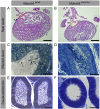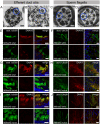Motility of efferent duct cilia aids passage of sperm cells through the male reproductive system
- PMID: 33561200
- PMCID: PMC7936721
- DOI: 10.1093/molehr/gaab009
Motility of efferent duct cilia aids passage of sperm cells through the male reproductive system
Abstract
Motile cilia line the efferent ducts of the mammalian male reproductive tract. Several recent mouse studies have demonstrated that a reduced generation of multiple motile cilia in efferent ducts is associated with obstructive oligozoospermia and fertility issues. However, the sole impact of efferent duct cilia dysmotility on male infertility has not been studied so far either in mice or human. Using video microscopy, histological- and ultrastructural analyses, we examined male reproductive tracts of mice deficient for the axonemal motor protein DNAH5: this defect exclusively disrupts the outer dynein arm (ODA) composition of motile cilia but not the ODA composition and motility of sperm flagella. These mice have immotile efferent duct cilia that lack ODAs, which are essential for ciliary beat generation. Furthermore, they show accumulation of sperm in the efferent duct. Notably, the ultrastructure and motility of sperm from these males are unaffected. Likewise, human individuals with loss-of-function DNAH5 mutations present with reduced sperm count in the ejaculate (oligozoospermia) and dilatations of the epididymal head but normal sperm motility, similar to DNAH5 deficient mice. The findings of this translational study demonstrate, in both mice and men, that efferent duct ciliary motility is important for male reproductive fitness and uncovers a novel pathomechanism distinct from primary defects of sperm motility (asthenozoospermia). If future work can identify environmental factors or defects in genes other than DNAH5 that cause efferent duct cilia dysmotility, this will help unravel other causes of oligozoospermia and may influence future practices in genetic and fertility counseling as well as ART.
Keywords: efferent ducts / cilia / sperm / motor proteins / outer dynein arm-defects / DNAH5 / 45 male infertility / oligozoospermia / motile ciliopathy / primary ciliary dyskinesia.
© The Author(s) 2021. Published by Oxford University Press on behalf of European Society of Human Reproduction and Embryology.
Figures








Similar articles
-
Defects in the cytoplasmic assembly of axonemal dynein arms cause morphological abnormalities and dysmotility in sperm cells leading to male infertility.PLoS Genet. 2021 Feb 26;17(2):e1009306. doi: 10.1371/journal.pgen.1009306. eCollection 2021 Feb. PLoS Genet. 2021. PMID: 33635866 Free PMC article.
-
Mutations in DNAH17, Encoding a Sperm-Specific Axonemal Outer Dynein Arm Heavy Chain, Cause Isolated Male Infertility Due to Asthenozoospermia.Am J Hum Genet. 2019 Jul 3;105(1):198-212. doi: 10.1016/j.ajhg.2019.04.015. Epub 2019 Jun 6. Am J Hum Genet. 2019. PMID: 31178125 Free PMC article.
-
Recessive DNAH9 Loss-of-Function Mutations Cause Laterality Defects and Subtle Respiratory Ciliary-Beating Defects.Am J Hum Genet. 2018 Dec 6;103(6):995-1008. doi: 10.1016/j.ajhg.2018.10.020. Epub 2018 Nov 21. Am J Hum Genet. 2018. PMID: 30471718 Free PMC article.
-
Sperm defects in primary ciliary dyskinesia and related causes of male infertility.Cell Mol Life Sci. 2020 Jun;77(11):2029-2048. doi: 10.1007/s00018-019-03389-7. Epub 2019 Nov 28. Cell Mol Life Sci. 2020. PMID: 31781811 Free PMC article. Review.
-
Ciliary defects and genetics of primary ciliary dyskinesia.Paediatr Respir Rev. 2009 Jun;10(2):51-4. doi: 10.1016/j.prrv.2009.02.001. Epub 2009 Apr 18. Paediatr Respir Rev. 2009. PMID: 19410201 Review.
Cited by
-
[Primary ciliary dyskinesia].Inn Med (Heidelb). 2024 Jun;65(6):545-559. doi: 10.1007/s00108-024-01726-y. Epub 2024 May 27. Inn Med (Heidelb). 2024. PMID: 38801438 Review. German.
-
Cilia and Cancer: From Molecular Genetics to Therapeutic Strategies.Genes (Basel). 2023 Jul 11;14(7):1428. doi: 10.3390/genes14071428. Genes (Basel). 2023. PMID: 37510333 Free PMC article. Review.
-
Current and Future Treatments in Primary Ciliary Dyskinesia.Int J Mol Sci. 2021 Sep 11;22(18):9834. doi: 10.3390/ijms22189834. Int J Mol Sci. 2021. PMID: 34575997 Free PMC article. Review.
-
Pathogenic gene variants in CCDC39, CCDC40, RSPH1, RSPH9, HYDIN, and SPEF2 cause defects of sperm flagella composition and male infertility.Front Genet. 2023 Feb 17;14:1117821. doi: 10.3389/fgene.2023.1117821. eCollection 2023. Front Genet. 2023. PMID: 36873931 Free PMC article.
-
The impact of primary ciliary dyskinesia on female and male fertility: a narrative review.Hum Reprod Update. 2023 May 2;29(3):347-367. doi: 10.1093/humupd/dmad003. Hum Reprod Update. 2023. PMID: 36721921 Free PMC article. Review.
References
-
- Becker O. Ueber Flimmerepithelium im Nebenhoden des Menschen. Wiener Medizinische Wochenschrift 1856;6:184.
-
- Björndahl L, Barratt CLR, Mortimer D, Jouannet P. ‘How to count sperm properly’: checklist for acceptability of studies based on human semen analysis. Hum Reprod 2016;31:227–232. - PubMed
-
- Bracke A, Peeters K, Punjabi U, Hoogewijs D, Dewilde S. A search for molecular mechanisms underlying male idiopathic infertility. Reprod Biomed Online 2018;36:327–339. - PubMed
Publication types
MeSH terms
Substances
LinkOut - more resources
Full Text Sources
Other Literature Sources

